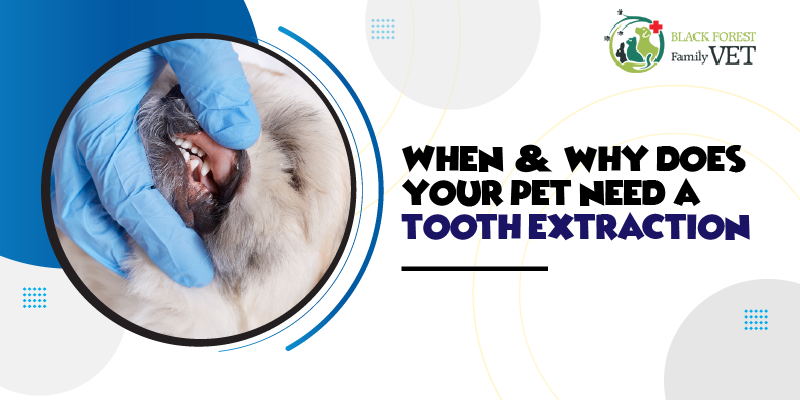When & why does your pet need a tooth extraction?

Maintaining proper oral health is vital for your furry companions. Just like humans, pets can also experience dental problems. Left untreated, it can lead to discomfort, pain, and other health problems. You may not always find out on your own when your furry friend is in pain. Pets rarely show signs of oral health issues. Dental problems usually happen gradually, and pets often learn to deal with them.
Pet Dental extraction is a crucial part of veterinary dentistry, and knowing when it is required is vital for responsible pet parenting. Understanding the underlying reasons for dental extractions helps determine when the procedure is necessary.
Why your pet needs a dental extraction
When a tooth is damaged, or the gum is diseased, it affects the pet’s oral health and can lead to severe pain. A tooth extraction is the best way to treat the condition and ensure the pet is pain-free and healthy. The process involves removing the crown, or visible part of the tooth, and the root below the gum. Never try to pull your pet’s tooth at home, even if it appears loose.
What are the signs that a dental extraction may be needed?
Identifying the signs that a pet may need a dental extraction ensures good oral health and overall well-being. Pay attention if you notice your pet displaying any of these signs:
- Persistent Bad Breath (Halitosis): Normally, a pet’s breath has a certain odor, but persistently foul breath can be a sign of dental issues. It indicates the presence of plaque, bacteria, or infection in the mouth.
- Difficulty Eating or Chewing: Pets with dental discomfort may have difficulty eating or chewing their food. They become reluctant to eat hard kibble, prefer softer food, or exhibit pain signs while chewing.
- Visible Signs of Dental Disease: Inspecting your pet’s mouth can reveal information about its oral health. Look for swollen or bleeding gums, discolored teeth, or visible tartar buildup.
- Loose or Missing Teeth: Teeth that are loose or visibly missing need a veterinarian evaluation. It may be a result of dental disease, trauma, or other underlying issues.
- Excessive Drooling: While some drooling is normal, excessive drooling may indicate oral discomfort. If you notice a sudden increase in drooling, have your pet’s mouth examined.
- Behavioral Changes: Pets in pain exhibit changes in behavior—they may become irritable, withdrawn, or reluctant to be touched around the mouth or face.
During Dental Extractions
Before a pet dental extraction, the veterinarian will clean the teeth and perform a dental X-ray to identify the damage. The vet will also conduct a physical assessment to plan the required course of action to restore the pet’s oral health.
Teeth have roots attached to the bone and need careful removal to extract the tooth correctly. For this, the pet will be under anesthesia during the extraction. Before pulling out the tooth, veterinarians use special instruments to break down the periodontal ligaments attached to the bone.
After a Dental Extraction
Pets are often discharged the same day after the extraction. You may notice a little blood-stained saliva from the gums post-extraction, but no significant bleeding must occur. A common thing seen in most pets is holding their tongue in a different position or moving it more as they get used to the new feeling.
Avoid rough play or giving them chews or hard food during recovery. The vet may prescribe a few pain medications and antibiotics for some days. Complications are rare, including damage to the jawbone and dental cavities failing to heal fast.
Failing to Extract Teeth
Some pet owners get worried about the effects of anesthesia, which causes them to make poor decisions. Leaving a damaged tooth causes unnecessary trauma to the pet, and a tooth that is far gone may not respond to cleaning.
Failing to remove a diseased tooth leads to a root infection, which can get into the bloodstream and travel to the kidney. Removing the tooth helps prevent future health complications. So, you must ensure you properly care for your pet’s dental health to prevent oral issues.
The bottom line
For pet dental extraction, consult closely with a qualified veterinarian or veterinary dentist. These experts can evaluate the pet’s specific condition and recommend the best action for its overall oral health and well-being. Remember, a healthy mouth contributes to a happy and playful pet. To protect your pet’s oral health, visit Black Forest Family Vet, SA, or Call +08 7089 9550 to schedule an appointment today.